For months now, I have been hearing about the saltwater intrusion coming into the Mekong Delta which has been ruining crops. I was under the impression this was a new problem which has been caused by the Cambodian canal project (Funan Techo Canal), funded by the China Bridge and Road Cooperation (CBRC). This project is purported to be diverting water away from Vietnam. As I investigated, I found out the project is still in the feasibility study phase of the project. Something else is going on, but what?
Somehow, this project became a scapegoat in the minds of farmers to explain the recent problem of large fields of crops dying. Not only is this wrong, but this saltwater intrusion was only the tip of the iceberg. There is so much more to the story.
What is the problem?
The Cambodian canal project has the farmers of the Mekong Delta in Southern Vietnam worried. I have been told by local farmers, who seem to think the project is already done, that the canal is the reason why farms are failing around the Delta. Stories abound of farmers around the southern and eastern parts of the Delta who have already lost crops because of saltwater intrusion into the water table. This is destroying salt sensitive crops, with the number 1 crop of the region, rice, being the most severely affected.
Brian Eyler of Mekong Dam Monitor has said on the Vietnam Weekly Podcast, that some reduced water flow may be due to a new dam in Yunnan, China which went online earlier in 2024. The dam is currently in the process of filling. This may be partially responsible for decreased waterflow downstream, combined with what seems like an exceptionally hot dry season. These factors likely contributed to saltwater intrusion into the Delta earlier than expected, but there is even more to the story.
The Mekong Delta produces approximately half of the country's total rice production. Farmers in recent decades have seen a noticeable increase in their standards of living as rice yields have been steadily rising since 1961. This dramatic increase in yield has been due to two main factors, a nearly doubling of allotted land for rice production and improved agricultural methods such as synthetic fertilizers.
Any reductions to total yield not only threaten the food security of the region, but additionally threaten to throw all of these farmers back into the subsistence farming they knew decades ago.
Wikipedia notes increases in rice production since 1961:
The total land area brought under rice paddy production was 4.744 million hectares in 1961 and increased to 7.305 million hectares in 2007. Correspondingly, rice production in Vietnam which was 8.997 million metric tonnes in 1961 and 10.29 million metric tonnes in 1975, has increased to 35.567 million metric tonnes in 2007, nearly a fourfold increase from 1961 to 2007.
Already, prices of rice are expected to climb as a portion of this year's harvest has already been ruined. This threatens to cause the overall price of rice to rise globally as Vietnam is the number three exporter of rice behind India and Thailand. If trends continue the way they are going, Vietnam, which is also the fourth largest consumer of rice, may switch from a rice exporter to a rice importer.
Digging a little deeper into the story, we find that saltwater intrusion into the Delta has been a problem since at least November of 2019 when Aljazeera reported:
Salty seawater began to enter the Delta early in mid-November 2019 and by January this year, seawater was projected to reach 30-40km deeper than the annual average during the full dry season. Fast forward to mid-April, and the high salinity levels are expected to remain into May unless the monsoon season can help reset the balance.
Why is Vietnamese Rice Production so Important?
The quick answer is, Vietnam has more growing seasons than other regions, thus producing a double yield of rice. If we compare rice production in Vietnam compared to the other top worldwide volume producers of India, Thailand and China, the regions in Vietnam average one more growing season per year than in other regions.
Vietnam rice grow time 4.5 to 5 months, 2 growing seasons per year.
Thailand rice grow time 6-8 months, 1 growing season per year.
India rice growing time 6-9 months, 1 growing season per year.
The rice of this region has always had a bit more of a yield than in other regions. I have been reading “The Civilization of Vietnam” by Nguyễn Văn Huyên and he mentions that more than 50 years ago, most of the Mekong Delta as well as the Red River Valley in Vietnam have had two growing seasons per year versus the typical one growing season elsewhere. This double growing season extends slightly beyond the borders of Vietnam into adjacent fields in parts of Cambodia and China.
Why is this happening?
Many are targeting global warming, but that is not the only culprit.
Sea level rise is much less concerning than the larger problem, the rate of sinking of the Delta is much faster than the rate of the rise of sea level with a 2017 NIH study showing the Delta is sinking at a rate of 1.1 cm to 2.5 cm per year. Over the last 25 years, the Delta has sunk a total average of 18 cm, with some coastal areas sinking more than other areas. This rate of submersion is increasing rapidly, with the next 25 years expected to be much more severe.
Many scientists tend to agree that the cause of the sinking of the Delta is due to a lowering of the water level table by pumping out groundwater for agricultural or personal use. At the same time there has been increasing demand to extract construction quality sand or lower quality ‘filler’ sand to be dumped into the sea to increase the size of coastal land.
Typically, when there is threat of sea level rise, a country will create a series of dikes and flood control barriers to control changes to the water level. At the same time, that same country would need to create a system to control the flow of water. The goal is to keep salt water from flowing upstream during high tide and ruining crops. These are some of the same tactics developed by the Dutch to reclaim much of their best farmland from the sea.
Unfortunately, Vietnam faces the challenge of not having enough of the right type of sediment to compensate for the sinking Delta. The author of the 2017 NIH study, Minderhoud, mentions “there is simply too little sediment available to compensate for how fast the Delta sinks relative to sea level”.
All of this is on the heels of a global sand crisis. Many countries are reporting excessive sand exports and even sand piracy as countries such as Dubai or Singapore have pushed up the price of high-quality filler sand so high to build artificial islands or extend their coastline. This is stripping away some of the best beaches in the world of the very thing which attracts people to that area, the beautiful sandy beaches. Truth be told, even if Singapore and Dubai stop sand importation immediately, another country will likely pick up the slack for their own building projects because there is a shortage of sand globally.
Many scientists have already concluded that if nothing can be done, half of the Delta will be swallowed by the ocean as we approach the end of the century. We are already starting to see collapse in the most sensitive regions, near the epicenter of this catastrophe, Cà Mau. Rising seas are already encroaching from the South and from the East. Some homes have already begun slipping into the water.
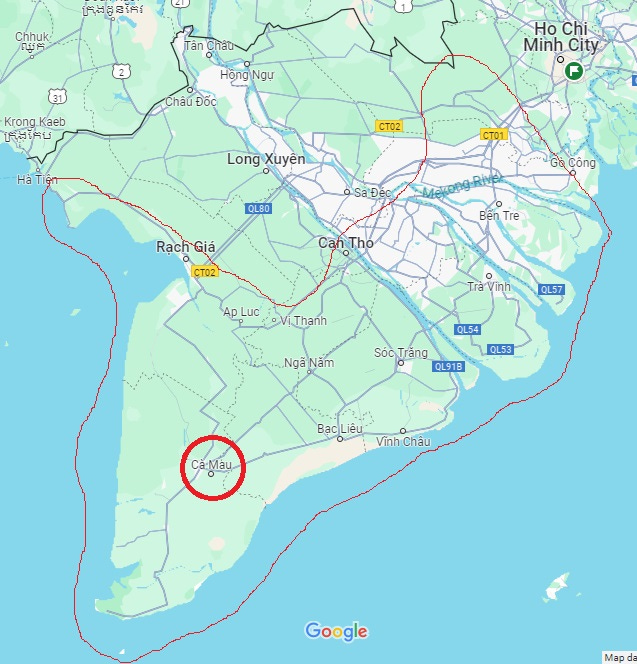
The Mekong is being hit on all sides as fertile sediment flowing downstream from the headwaters of the Mekong is being blocked by a series of dams starting in the Chinese headwaters near the Himalaya mountains, proceeding to various canals, siphoning off water for agriculture or trapping sediment as the water transits several countries before finally arriving in Vietnam.
In a final nail to the coffin, Cambodia announced the new canal system which will divert even more water and sediment through the canal causing that water to take an express trip to the ocean, diverting even more water away from being absorbed into Mekong Delta groundwater.
How did farmers deal with water in the past?
As I have been reading some historical accounts of Vietnamese life before and during the French Colonial period, I have realized that much of modern agriculture has deviated sharply from traditional agriculture.
Vietnamese farmers never really used ground water as their source of agricultural or drinking water. Farmers needed to create a system to harvest water during the rainy season to be used later during the dry season.
Originally, farmers in the two fertile breadbasket regions of Vietnam have been able to provide superior yields through a network of rain catching systems, holding ponds and canals. These systems had several usages beyond simple water storage.
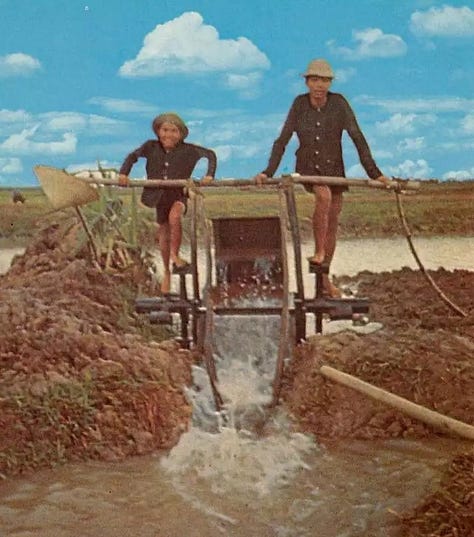
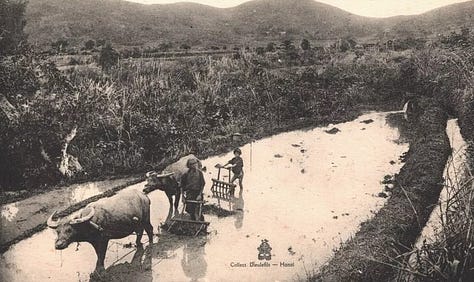
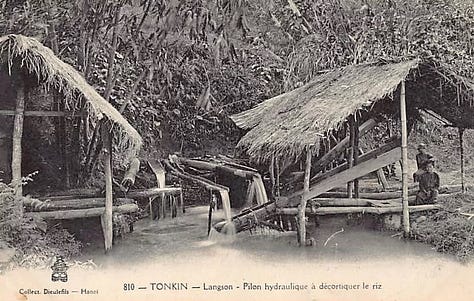
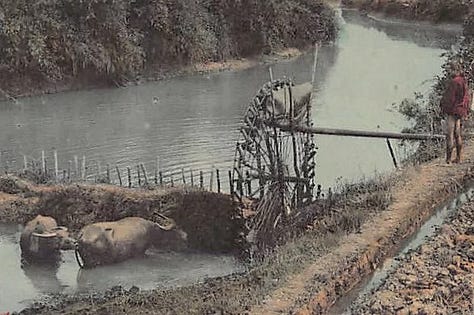
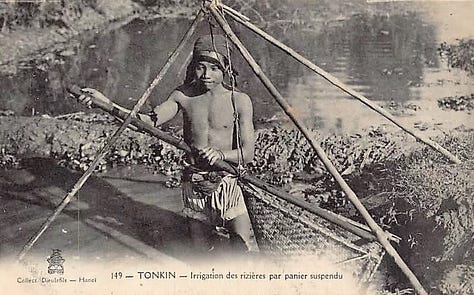
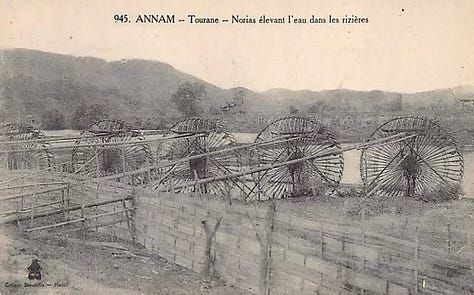
Typically drinking water would be stored in massive clay pots, each of which would contain hundreds of liters of water by the end of the rainy season. Ponds provided water for cleaning or agriculture while also containing a place to grow freshwater fish or other aquatic animals. This could provide the added benefit of nutrient rich water as a byproduct of waste captured within the ponds.
It is interesting to note that the old style of rice production depended heavily on animals such as the water buffalo and the domestic duck. I am sure you realize why the water buffalo is important, but many may not understand the importance of the duck.
Unlike chickens, which eat everything, ducks are skimmers. They tend to eat little pests around the water or on the surface of the soil. Ducks tend to stay away from eating rice plants while removing the pests surrounding the plant. It wasn’t too unusual for a person with a flock of ducks to have neighbors ask them to take their duck flock to other fields. As a byproduct, the ducks left quite a bit of phosphate rich fertilizer, which rice loves more than any other synthetic fertilizer component. I wouldn’t be too surprised if these duck herders actually charged farmers a few bags of rice in exchange for bringing their ducks to their neighbor’s fields.

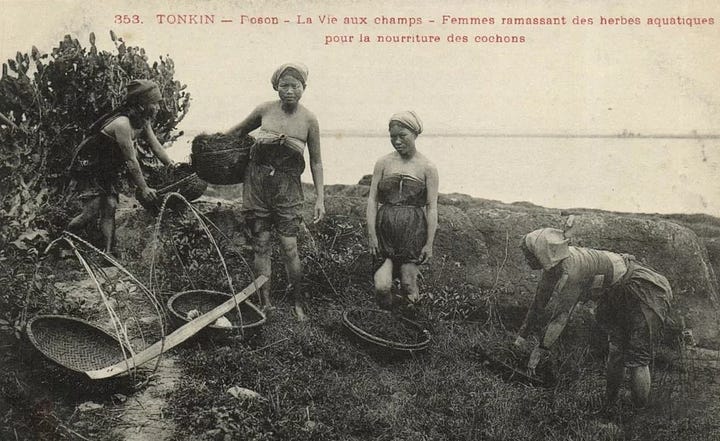
In addition, Vietnamese agriculture seems to be optimized when built around a network of canals or ponds. Some of the Vietnamese diet comes from water-based vegetation, including rau mồng, also called morning glory, water spinach or Malabar spinach, which loves growing around water. Much of these agricultural techniques are used today, but many have opted for Western style agriculture, which was largely based upon Western mass-agriculture which works best on plains than on the swampy terrain of the Delta.
Why did farmers abandon the old water management system?
Over the last several hundred years, Vietnam has basically been terraforming the Delta. Once Chinese agricultural methods for rice were introduced to the Delta, much of the swamp land has been systematically drained of water through a network of canals with the intention of converting swamp land into farmland. This has allowed the population of this region to skyrocket as immigration out of China, to escape political unrest, has come flooding into the region.
When the French arrived, the whole process shifted into high gear as the French introduced mechanical water pumps and ground drilling to extract groundwater, eliminating the trouble of storing massive amounts of rainwater.
Much of the land in the Delta has been converted from swamps, which have a high-water absorption rate, into flat dry fields or concrete buildings, which have a high rate of water runoff.
Additionally, concrete is heavy. Sand has been mined out of the soil and has been used to create concrete structures. Not only does it quickly channel water away from the land, but it is also heavy, causing faster sinking into the soil.
All of this rainwater is channeled through a series of canals until it is quickly diverted on a fast track to the sea. There aren’t sufficient large-scale methods of channeling rainwater into a series of holding ponds or cisterns which could seep into the ground water over time. Many water storage reservoirs are simply a band-aid to catch surplus water.
Part of the problem is cultural, where it is easier to turn on a pump rather than develop a water catching system. The resource of fresh rainwater is dealt with as a problem to quickly dispose of rainwater, rather than treat it as an important resource to be conserved.
It is not unusual to discover that certain highways and buildings around Southern Vietnam need frequent maintenance as natural underground canals develop which cause ground soil below the surface to quickly wash away, thus creating sinkholes.
It is a constant battle to reintroduce sand and soil to replace the underground soil which washes away every year. If the soil cannot be replaced, as you might see with roads, everything needs to be dug up and rebuilt. I have seen many road construction projects which seem to need frequent reconstruction every five years or so. Is this why Vietnam always seems to be under construction?
What to do going forward.
I wish I had answers, but I really don’t. The problem is too complicated for one person. It’s not really my place to give policy recommendations and tell local people what they should do. I’m not Vietnamese and local government officials have an aversion to being told what to do. My place is just to watch with trepidation.
I am just a guy who does a lot of reading. I know what has been done in the past. I suspect some of the old solutions may provide clues about what to do in the future. These old systems have the potential to be adapted for modern technology, to slow or potentially even stop this crisis from being passed to the next generation. I believe there is quite a bit of wisdom in the old ways which could have the potential to save the country.
The is problem ultimately in the hands of the government because the problem is way too large for a single farmer, or even farmer collective to handle on their own. This problem is going to need to be addressed on the province level and perhaps on the national level if they hope to save their rice production.
This is a very difficult management problem with several key factors which all need to be addressed at the same time.
How to maintain lower food prices by keeping yields high
How to deal with increased population growth in the Delta
How to preserve any fresh water which might be harvested or recycled
How to work with upstream neighbors to maintain the necessary flow of water into the Delta
Until these matters are addressed, the problems will only get worse and may result in one of the worst natural disasters to hit the country as well as having far reaching effects far beyond the borders of Vietnam.
The first three links are highly suggested if you want to learn more. They are followed by some sources which were used to find some facts which were peppered around the article.
https://www.aljazeera.com/features/2020/4/22/the-great-salt-drought-desiccating-vietnams-mekong-delta
https://en.wikipedia.org/wiki/Rice_production_in_Vietnam
https://thediplomat.com/2024/02/vietnams-climate-solutions-are-decimating-the-mekong-delta/
https://e.vnexpress.net/news/news/environment/cambodia-s-funan-techo-canal-could-upset-mekong-delta-ecosystem-experts-4738145.html
https://e.vnexpress.net/photo/environment/drought-salt-intrusion-destroy-mekong-delta-paddy-fields-4733890.html
https://www.undp.org/vietnam/publications/viet-nam-drought-and-saltwater-intrusion
https://www.sustainability-times.com/environmental-protection/the-mekong-delta-is-sinking-fast-but-it-can-still-be-saved/
https://ipad.fas.usda.gov/countrysummary/Default.aspx?id=VM&crop=Rice
https://worldpopulationreview.com/country-rankings/rice-consumption-by-country
https://www.todayonline.com/singapore/explainer-why-sand-so-highly-valued-and-consequences-overmining
https://pubmed.ncbi.nlm.nih.gov/30344619/#:~:text=We%20find%20that%20subsidence%20related,a%20consequence%20of%20groundwater%20withdrawal.




Another interesting article. Thanks.
"It’s not really my place...", then "These old systems have the potential..."
You are much better than I in communicating the VN way.
What an interesting post. Between, Dubai, China and Singapore they have removed so much sand to extend their borders, and more so China with their ‘island’ in the middle of the China Sea. It is such a sad affair that due to drawing water from underground it is causing the Delta to be sinking, plus the effect of salt water damaging the crops. I’m not sure how much we rely on rice from Vietnam, probably more so from India, but we are fortunate to have our own rice growers which provide most of the rice I use.